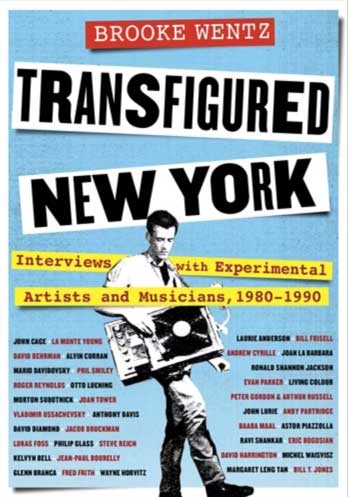
Transfigured New York, Brooke Wentz (324pp, Columbia University Press)
Transfigured New York is a fantastic collection of Interviews with Experimental Artists and Musicians, 1980-1990, transcribed from discussions Wentz conducted as part of her radio programme Transfigured Night on Columbia University’s own radio station in 980s New York. The book really captures what was happening across the city: contemporary classical, electronic and tape music, classical composers, modern jazz musicians, out-rock, mutant pop, world music and performance art, with each interview given a new, short, contextualising introduction.
Wentz has made careful groupings of her interviews, which after a lively introduction to the book by Lee Ranaldo (who of course was there as part of Sonic Youth), starts with the pairing of John Cage and La Monte Young, who she declares to be ‘The Founding Theorists: Influential figures of Contemporary Thought and Musical Composition’. Cage is in a retrospective mood, having recently gone through his back catalogue, and is focussed on ‘listening to the world around you’ and what he calls ‘paying attention to signs’, whilst La Monte Young declares he has ‘dedicated his life to music because I’m crazy about music’, and wishes to get his music heard.
Part II gathers up those Wentz regards as ‘The Materials Scientists’, which includes a host of unknown (to me) names alongside David Behrman, Alvin Curran and Morton Subotnick. Here questions of systems, electronics, computers, assemblage and composition are addressed, with a whole host of differing models and attitudes evidenced. It’s amazing to think how the digital world and the continuing evolution of computer systems – now including AI – have made the kind of work undertaken in the 80s technically easy to do.
Part III focusses on composers who write or wrote in more traditional ways, including the Minimalists Philip Glass and Steve Reich before they got truly famous and were still embedded in alternative venues and scenes, and the pianist Anthony Davis, whose New Music was rooted in jazz idioms. Part IV is a rather loose collection of five ‘Eccentric Thought-Provoking Performers’, which allows improviser/composer/guitarist Fred Frith to sit alongside noisemeister and provocatuer Glenn Branca and alt-jazz musician Wayne Horvitz. It’s hard to see why Laurie Anderson isn’t here too, instead of Part V where she and Joan La Barbara are called ‘The Vocalists: Experimenters with Voice and Words.’ Anderson could also have been included in ‘The Performance Artists’ section, later on. Either way, hers is one of the best interviews here, focussing on her earlier compositions and events, but also discussing her intention to assemble a bigger piece entitled United States, which of course she did.
Part VI groups Andrew Cyrille, Bill Frisell, Ronald Shannon Jackson and Evan Parker as ‘The Dissenters: Modern Jazz Innovators’, which includes an enormous area of musical ground, from Cyrille’s avant-garde drumming to Parker’s cyclical-breathing saxophone improvisation with multiphonics, via Frisell’s atmospheric shading and wigout guitar, as well as Shannon Jackson’s deconstructed funk. It’s hard to see why Frith isn’t included in this section, or why he, Parker and Andy Partridge are the three UK visitors included in the book.
In fact, some of the strange groupings are one of the problems with the book. Take ‘Part VII. The Popular Avant-Garde: Pop Idiom Crossovers’. I’m not sure how Living Color differ that much from Shannon Jackson and The Decoding Society, why John Lurie and his fake-jazz band The Lounge Lizards aren’t in the jazz section, just how popular Arthur Russell (interviewed here with Peter Gordon) was until after his death; and I am definitely bemused to find Andy Partridge regarded as ‘experimental’. I loved early XTC, but they were post-punk pop through and through, even early on with the likes of ‘This Is Pop’ and ‘Statue of Liberty’, despite recorded evidence of their occasional deconstructionist dub tendencies.
The strange labels continue with ‘The Global Nomads’, interviews with Baaba Maal, Astor Piazzolla and Ravi Shankar, who are flagged up as ‘International Superstars of Western Thought’, a phrase whose meaning I have no idea of! Again, it seems that Shankar was already famous, whilst Maal and Piazolla were yet to achieve the musical presences they would go on to. The book sputters out a bit, with five people I have never even heard of gathered up in a ‘Performance Artists’ section.
I’d like to have perhaps seen a chronological arrangement of the pieces, or even an alphabetical one, something that resisted the kind of grouping exercise and labelling that has been imposed here and perhaps foregrounded more the musical and personal links, interdisciplinary playing and cross-genre influences that were occurring at the time. (Some sort of diagram or flow chart might have been fun!) The shorter, contemporary reflections by musicians which are sprinkled throughout the book offer different points of view and help offer retrospective contextualisation, including highlighting the effects of AIDS and other social and other political events.
This isn’t a definitive history of New York music in the 1980s, there are too many big names missing and the interviews are very much undertaken with regard to what was going on then, what musicians were involved in and about to perform, compose or play. This is both a positive and a negative, as some of the interviews seem slight in comparison to the more reflective and summative ones with the likes of John Cage or Morton Subotnick. Wentz, of course, can only work with what she has, and wasn’t interviewing for posterity, but we should be glad that several decades later this material is available so we can reconsider how music was changing and had changed, who was playing where and when, and the part New York City played in nurturing new and challenging music.
Rupert Loydell
.
